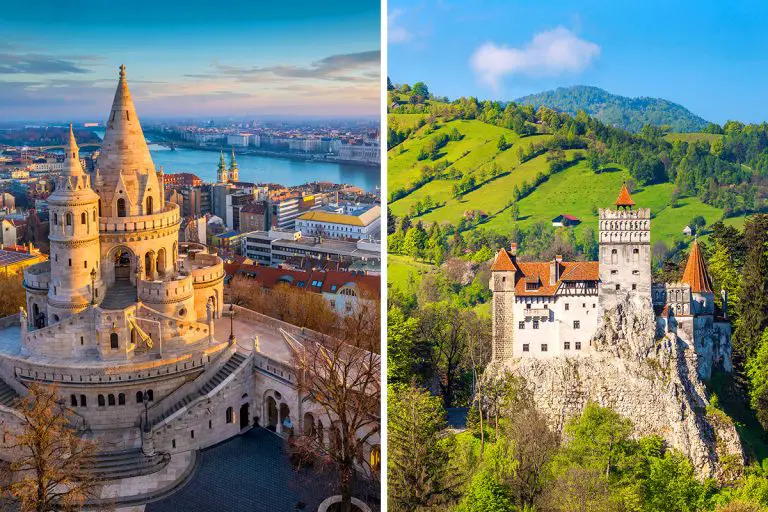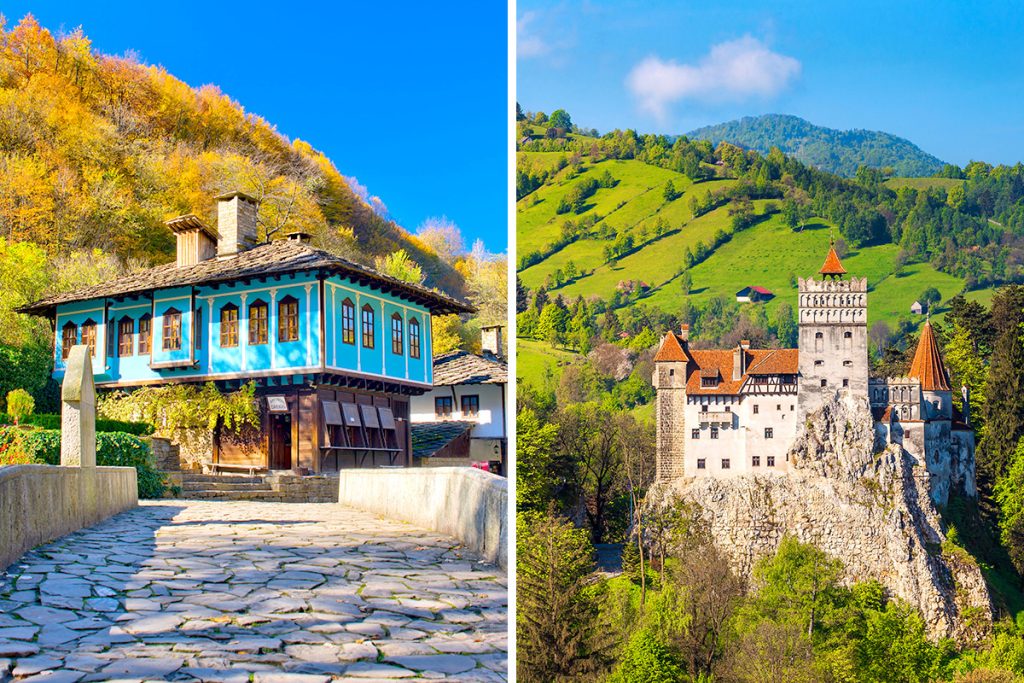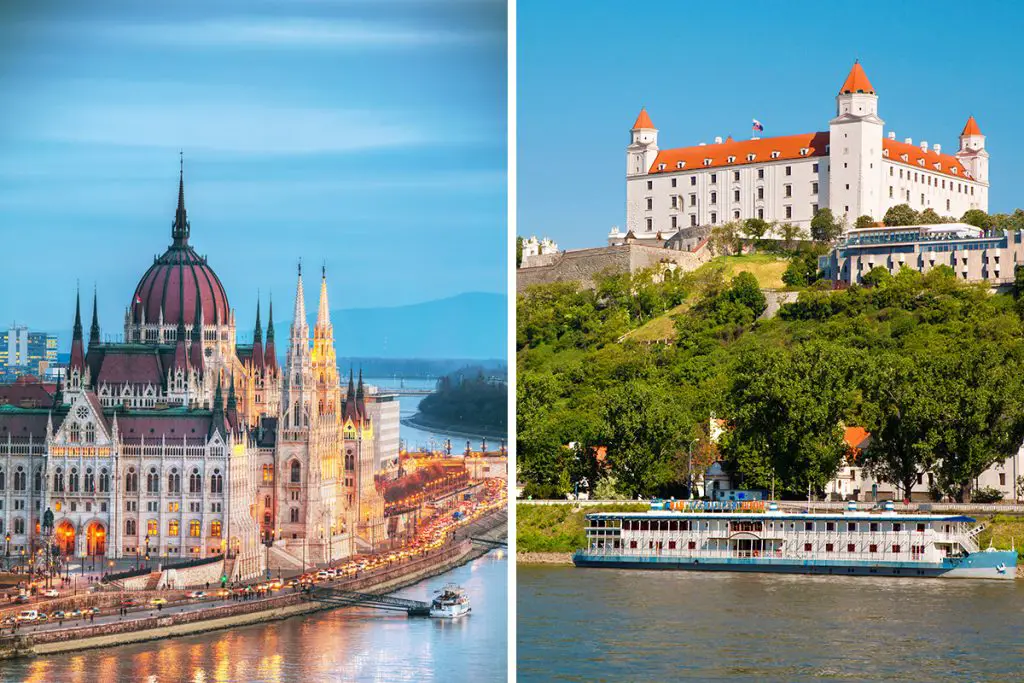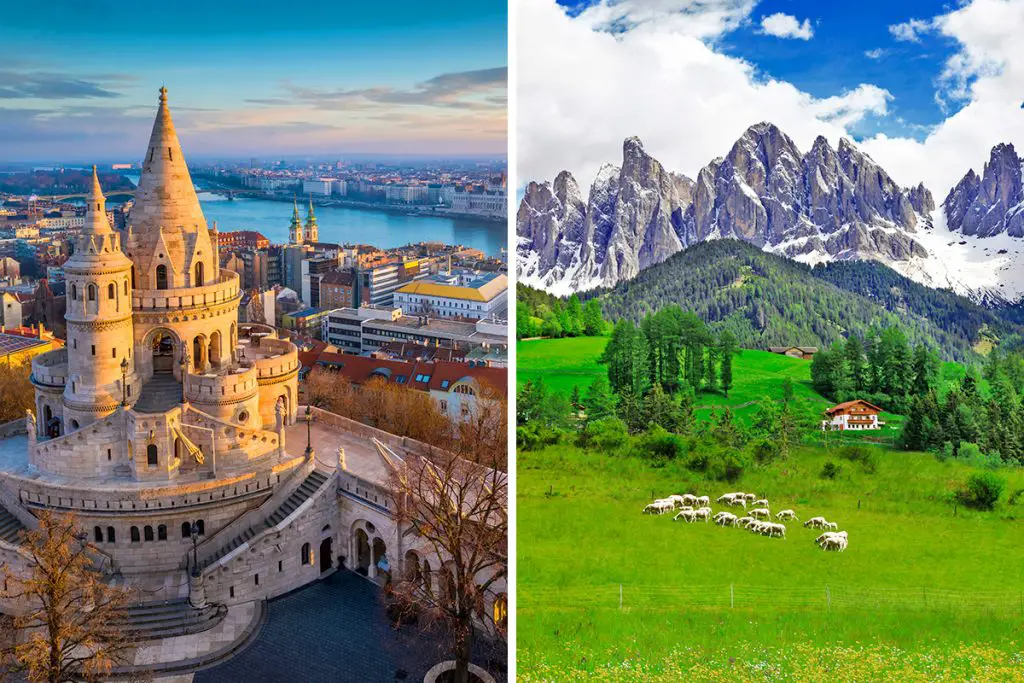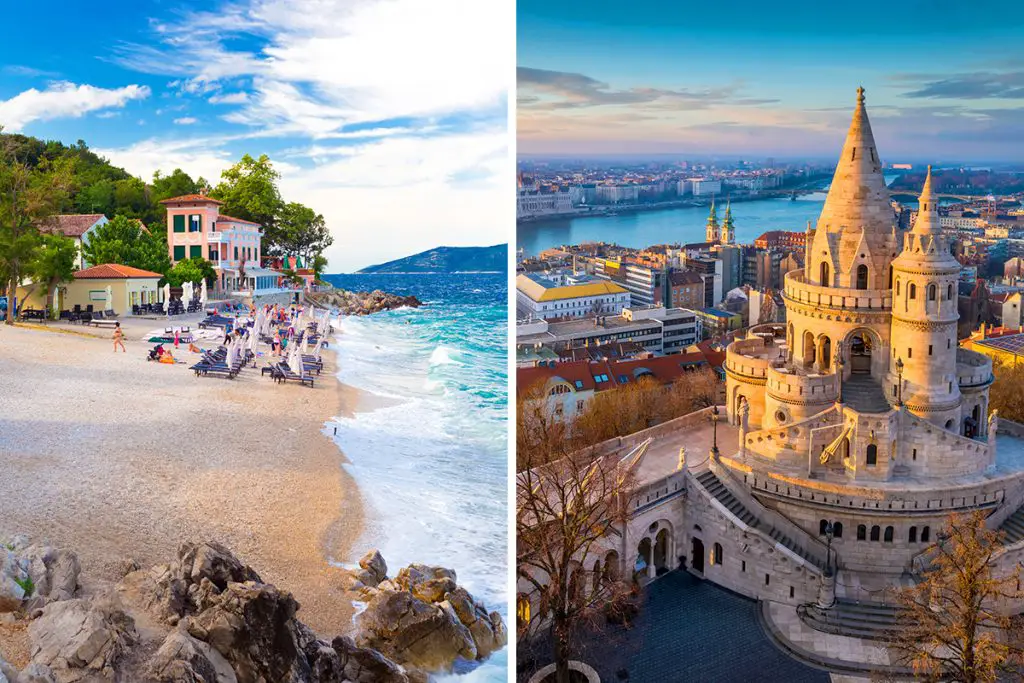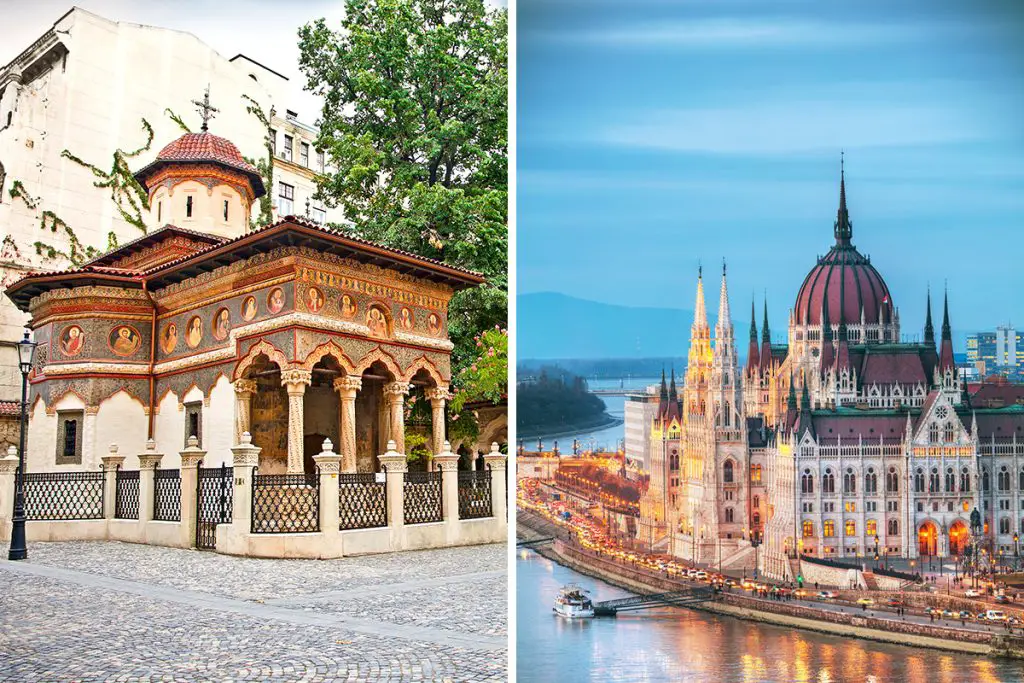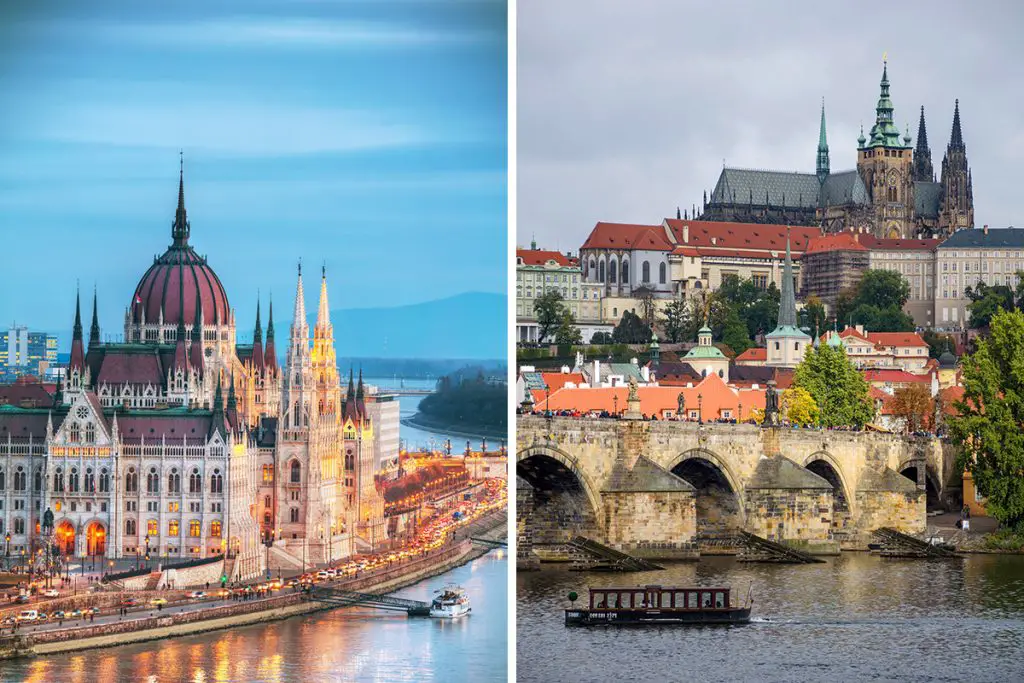Hungary and Romania, two jewels in the crown of Europe, each offer a unique journey into their historic past and vibrant cultures. Picking one over the other isn’t easy, so why not discover more about each? Stay with us as we delve into the intriguing stories these countries have to tell.
History & Culture
Hungary and Romania, each with their own distinct past, offer you a vibrant tapestry of history and culture. From medieval times to the modern day, their stories are etched in every town square and whispered in the wind.
Hungary, nestled in Central Europe, has a remarkable historical depth.
Remembered for its mighty kingdom in the Middle Ages, Hungary’s history is like a colorful quilt, filled with diverse patterns. It’s a land of brave kings and queens, of epic battles and peace treaties. And this vibrant history has woven itself into the culture of the people, resulting in a blend of tradition and modernity that gives Hungary its unique flavor.
On the other hand, Romania, located in Eastern Europe, has its roots deeply embedded in folklore and tradition. Its rich history is filled with legendary figures, mythical beasts, and fairy tale castles. From the powerful Dacians to the influential Romans and the tumultuous 20th century, Romania’s past is as varied as it is compelling.
Its culture, too, is a tapestry of tradition, with folk dances, music, and crafts that are still very much a part of daily life.
Comparing Hungary and Romania is like looking at two different yet equally beautiful paintings. In Hungary, the picture is one of a regal past blending seamlessly with the vibrant present. In Romania, the canvas is filled with the deep, bold colors of tradition and folklore.
In a nutshell, whether it’s the historic depth of Hungary or the vibrant folklore of Romania that captures your interest, you’re guaranteed an unforgettable journey. The echoes of the past and the rhythms of the present combine to create a fascinating symphony of history and culture in both these remarkable countries. Now, where will your journey take you next?
Attractions & Activities
When it comes to attractions and activities, both Hungary and Romania offer an abundance of options to keep you captivated. Unfold the adventure that awaits you as you immerse yourself in the heart of these European gems.
Hungary, most notably its capital Budapest, offers you a diverse array of attractions. Stand atop Gellért Hill, about 771 feet (235 meters) high, and take in the panoramic view of the city. Visit the iconic Parliament Building, with its Gothic Revival style, sure to spark your interest.
For nature enthusiasts, venture into Bükk National Park, located about 71 miles (114 kilometers) east of Budapest, a paradise with sprawling forests and hidden caves.
Across the border, Romania has a magic of its own. Visit the enchanting Peles Castle, nestled in the Carpathian Mountains. This Neo-Renaissance castle, about 75 miles (121 kilometers) north of the capital Bucharest, was once the summer residence of Romanian royalty.
If you’re a fan of legendary tales, you can’t miss the Bran Castle in Transylvania, famously associated with the Dracula legend. Don’t forget the Transfagarasan Road, often hailed as one of the world’s most picturesque driving routes.
Both Hungary and Romania offer a wide range of activities that plunge you into their unique character. From the panoramic views atop Gellért Hill in Hungary to the legendary Bran Castle in Romania, you’ll find yourself immersed in a world of exploration and discovery. Each step you take unveils a new layer of their rich heritage and unique personality.
Beaches
The allure of the beach is universal, and both Hungary and Romania offer unique seaside experiences. Let’s dive into what each destination has to offer in terms of sandy retreats and cool waters.
Hungary, a landlocked country, may not have seaside beaches, but it more than makes up for it with Lake Balaton, Central Europe’s largest freshwater lake. Spanning approximately 48 miles (77 kilometers) in length, its shores are dotted with sandy beaches, providing an excellent alternative to seafronts.
Balatonfüred, a popular resort town on the northern shore, invites you to enjoy the sun and take a refreshing dip in the lake’s soothing waters.
On the other hand, Romania, with its eastern border nestled on the Black Sea coast, offers sandy beaches that stretch over 152 miles (245 kilometers).
The town of Mamaia, situated about 8 miles (13 kilometers) north of the port city of Constanța, is one of Romania’s most popular seaside resorts. With its golden sands and clear waters, it’s a haven for sun-worshippers and water lovers alike.
Whether you’re lounging on the sandy shores of Lake Balaton in Hungary or soaking up the sun on the Black Sea beaches in Romania, you’re in for a delightful experience. Each destination offers a unique setting for your beach adventures. After all, what’s a vacation without a little sand between your toes? So, ready to let the waves of relaxation wash over you?
Eating, Drinking & Nightlife
A vacation is never complete without indulging in local flavors, savoring the local drinks, and immersing oneself in the vibrant nightlife. Both Hungary and Romania have distinctive culinary scenes, unique beverages, and lively night scenes that will keep you entertained and well-fed.
In Hungary, the culinary scene is as rich as its history. Dive into a bowl of traditional goulash, a hearty stew that’s a national favorite. For dessert, you won’t want to miss out on sampling somlói galuska, a delicious trifle with cream and rum.
Hungarian wine is world-class, with regions like Tokaj and Eger producing some of the finest bottles. When it comes to nightlife, Budapest takes center stage with its ‘ruin bars’, unique hangouts situated in old, refurbished buildings that create a unique atmosphere.
Romania, on the other hand, offers dishes that are deeply rooted in its rural heritage. Sarmale, cabbage rolls stuffed with meat and spices, are a must-try. For a sweet treat, papanasi, a cheese-filled doughnut, is absolutely delightful.
Traditional Romanian drinks include tuica, a potent plum brandy, and visinata, a sweet cherry liqueur. Romania’s nightlife scene is diverse, from Bucharest’s trendy clubs and music bars to Brasov’s cozy cafes and live music venues.
Whether it’s the hearty goulash of Hungary, the soulful sarmale of Romania, or the vibrant nightlife of both, you’re in for a memorable experience. It’s a delicious journey of taste, a flavorful celebration of tradition, and a vibrant display of local culture that will leave you wanting more.
Shopping
If you love shopping, then you’re in for a treat. Both Hungary and Romania offer a variety of shopping experiences, each unique and reflective of their distinct culture and traditions.
In Hungary, Budapest offers a mix of modern shopping malls like WestEnd City Center, and traditional markets such as the Great Market Hall. The latter is an architectural gem where you can find a range of products from authentic Hungarian paprika to handmade crafts. For unique Hungarian souvenirs, don’t miss out on Herend Porcelain, known for its exquisite designs and high quality.
Meanwhile, Romania offers a different shopping experience. Bucharest’s Unirea Shopping Center houses a wide array of international brands. But the true charm lies in the local markets like Piata Obor, where you can find everything from fresh produce to traditional Romanian crafts.
If you’re looking for souvenirs, Romanian wooden spoons or “lingurari” showcase the local craftsmanship and make for a unique memento.
In conclusion, whether it’s the grandeur of Budapest’s Great Market Hall in Hungary or the vibrant local markets of Romania, your shopping experience will be nothing short of exciting. Each destination offers a unique blend of modern retail and traditional markets that will satiate your shopping desires. So, are you ready to discover the treasures that await you?
Accommodation
Finding a comfy place to rest your head at night is a crucial part of any vacation. In both Hungary and Romania, you’ll find a variety of accommodation options to suit your needs and budget.
In Hungary, specifically Budapest, luxury lovers can opt for opulent stays like the Four Seasons Hotel Gresham Palace, known for its Art Nouveau architecture and riverfront location. For a more budget-friendly option, consider the Maverick City Lodge, a stylish hostel in the heart of the city.
If you’re looking for a unique experience, the Brody House offers artist-themed rooms in a bohemian setting.
Romania, on the other hand, offers its own selection of stays. Bucharest’s luxury hotels like the Athenee Palace Hilton provide a blend of history and modern comfort. For budget travelers, Podstel Bucharest offers cozy rooms and a warm, friendly atmosphere.
Fancy staying in a piece of history? Try the Casa Wagner in Brasov, located in a historic building in the city’s main square.
Whether you choose the regal luxury of Budapest, Hungary, or the historic charm of Bucharest, Romania, you’ll find an accommodation option that feels just like home. Each destination offers comfort, variety, and a touch of local flavor that adds to the overall travel experience.
Family-Friendliness & Children’s Activities
Taking a vacation with the whole family can be a joyous adventure. Both Hungary and Romania are well-equipped to offer family-friendly environments and activities that will keep the little ones entertained.
In Hungary, the Budapest Zoo & Botanical Garden, one of the oldest in the world, is a hit among children. The city also boasts interactive museums like the Palace of Miracles, featuring science and technology exhibits in a fun, engaging manner.
Romania, too, caters well to family holidays. The Grigore Antipa National Museum of Natural History in Bucharest offers educational fun, with exhibits ranging from dinosaur fossils to butterfly collections. For an outdoor adventure, families can visit Aventura Park in Brasov, an exciting outdoor climbing and adventure course set in the forest.
Whether it’s the interactive exhibits in Hungary or the outdoor adventures in Romania, both destinations provide a wealth of fun-filled, educational, and engaging activities that are perfect for families. Each country is committed to ensuring that your family vacation is nothing short of amazing.
Getting There & Getting Around
Travel involves not just the destination, but also the journey. So, how do you get to Hungary and Romania, and how do you navigate around these countries once you arrive?
To reach Hungary, Budapest Ferenc Liszt International Airport is the largest in the country, with numerous international flights. It’s located about 10 miles (16 kilometers) southeast of Budapest city center. Romania’s busiest airport is Henri Coandă International Airport in Bucharest, situated roughly 10.3 miles (16.5 kilometers) north of the city.
Once you’re in Hungary, you’ll find that Budapest has an efficient public transportation system, including metros, buses, and trams. For Romania, Bucharest offers the metro, buses, and trams, while in smaller cities and towns, buses and taxis are the primary modes of transportation.
Whether you’re jetting off to Hungary or Romania, rest assured that getting there and getting around is straightforward and convenient. Both countries offer reliable and efficient transportation options that make exploring their beautiful cities and towns a breeze. So, where are you off to first?
Weather
Weather plays a significant role in planning your vacation. Understanding the climate in Hungary and Romania can help you pick the best time to visit.
Hungary enjoys a continental climate, with warm summers and chilly winters. The warmest months are July and August, with temperatures ranging around 79°F (26°C). The coldest month is January, when temperatures can drop to 32°F (0°C).
Romania’s climate is slightly more diverse, with coastal, continental, and even mountainous climates. Summers are generally hot, particularly in July and August, when temperatures can rise up to 86°F (30°C). Winters, especially January, can be particularly cold with temperatures dipping down to 23°F (-5°C).
Whether you prefer the warm summers of Hungary or the varied climate of Romania, both offer distinctive weather patterns that can cater to different preferences. So, do you prefer soaking in the summer sun or exploring in the chill of winter?
Safety
Safety is a top concern for any traveler. Rest assured, both Hungary and Romania are generally safe countries with low crime rates.
In Hungary, petty crime like pickpocketing can occur in tourist areas, but it’s not widespread. Meanwhile, Romania has similar safety levels. Pickpocketing and scamming can happen, but they are typically confined to busy areas.
One unique safety factor in both countries is road safety. In Hungary, it’s important to be aware that driving can be challenging due to the country’s strict traffic laws. Similarly, in Romania, cautious driving is advised due to varying road conditions.
In conclusion, whether you’re strolling through the streets of Budapest or exploring the landscapes of Romania, you can feel secure. Remember, staying vigilant and following local laws will ensure you have a safe and enjoyable trip.
Cost
Planning your budget is an important part of any travel experience. Let’s delve into the costs you can expect when visiting Hungary and Romania.
Hungary, particularly Budapest, can offer good value for your money. A meal at an inexpensive restaurant would cost around 2,000 HUF ($6), while a night at a mid-range hotel can set you back about 20,000 HUF ($60).
Romania, on the other hand, is known to be one of the most affordable countries in Europe. A meal at an inexpensive restaurant could cost around 30 RON ($7), while a night in a mid-range hotel might cost approximately 200 RON ($48).
So, whether you’re planning a lavish vacation or traveling on a shoestring budget, both Hungary and Romania offer value at every price point. Are you ready to start budgeting for your next exciting adventure?
Which Is Better – Hungary or Romania?
Deciding between a vacation in Hungary or Romania is a tough task, with each offering its own unique charms and experiences. Let’s recap what we’ve explored about both destinations to help you make your choice.
In terms of history and culture, Hungary stands out with its Ottoman and Habsburg influences, seen clearly in its architecture and traditions. However, Romania, with its rich history from the Dacian civilization to its communist past, provides a more varied historical palette.
When considering attractions and activities, Hungary offers the thermal baths and the iconic Parliament Building among other landmarks, while Romania boasts the stunning Peles Castle and the Carpathian Mountains for a taste of nature.
On the coastline, Romania wins hands down, with its access to the Black Sea providing a unique beach experience. Hungary, while landlocked, does offer lakeside relaxation and water sports at Lake Balaton.
As for food and nightlife, Hungary is known for its hearty cuisine and vibrant nightlife in Budapest. Yet, Romania matches this with its traditional meals and growing cafe culture and nightlife in cities like Bucharest and Cluj-Napoca.
In terms of shopping, both countries offer unique local products. Hungary is known for its porcelain and paprika, while Romania offers handmade items such as painted eggs and traditional costumes.
For accommodations, both Hungary and Romania cater to various budgets and preferences, from luxury hotels to budget-friendly hostels. The choice depends on your individual needs and taste.
Family-friendly activities are abundant in both countries. However, the nature-oriented activities in Romania might edge out Hungary for those with a love for the great outdoors.
Getting there and getting around is straightforward in both countries, with efficient public transportation systems in the major cities.
Weather-wise, both countries have distinct seasons, with hot summers and cold winters, though Romania offers a more diverse climate due to its geography.
In terms of safety, both countries are generally safe for tourists, with road safety being a point of note in both.
As for costs, while both destinations are affordable compared to other European countries, Romania is often considered one of the most budget-friendly countries in Europe.
So, when to choose which? If you prefer a blend of history, vibrant city life, and a love for hearty food, then Hungary, particularly Budapest, is your destination. On the other hand, if you seek diverse history, a taste of nature, coastal relaxation, and a budget-friendly trip, then Romania should be your choice. Your decision boils down to your personal preferences, and no matter the choice, rest assured, both Hungary and Romania offer enriching experiences that leave lasting memories.

